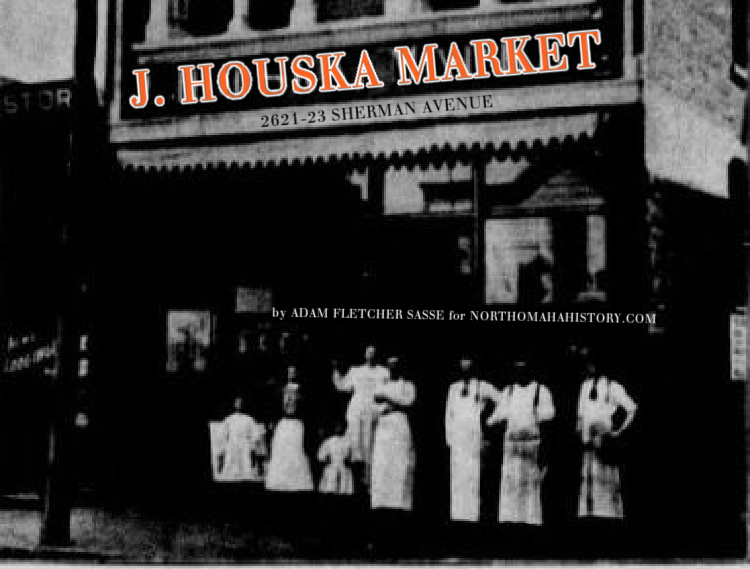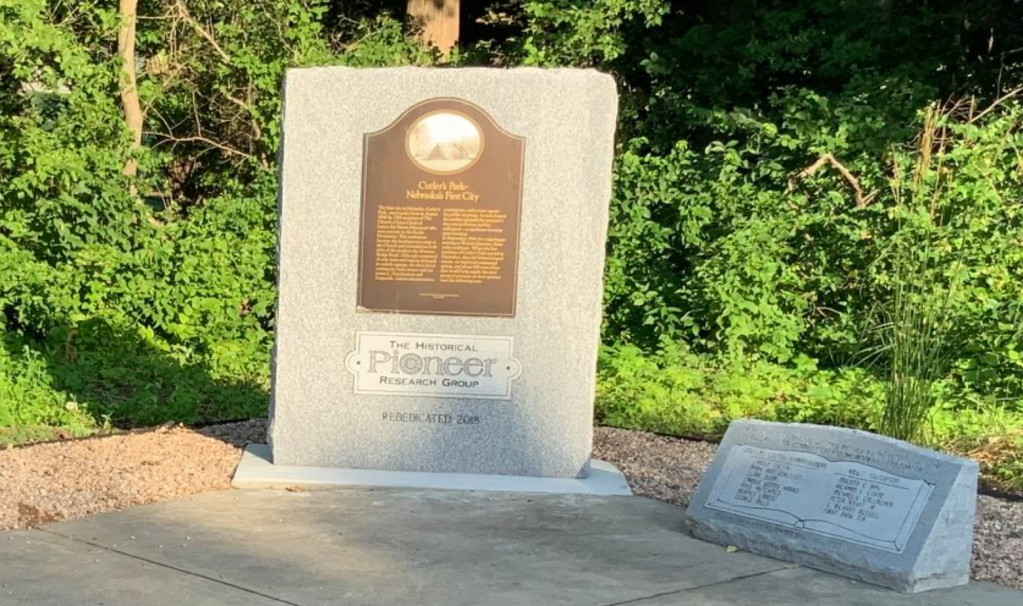Special thanks to Ryan Roenfeld for the lead on this building.
Today, much of North 16th Street stands empty and completely devoid of any acknowledgment of its history and significance to the city of Omaha. However, for more than 75 years it was a bustling artery filled with nice apartments, fine homes, packed streetcars, and important businesses. With much of that gone now, its hard to imagine what was here. Here is a history of one of the buildings that’s been gone now for more than 40 years, 2621 North 16th Street.
Building a Behemoth

Located on the southeast corner of North 16th and Corby Street, this building was constructed around 1893. Built in the Victorian-era, the building had Jacobean details with a commercial space on the first floor and at least two apartments on the second floor. A Czech grocer named Joseph Houska (1856-1930) had the building constructed on a plot of land he owned, including a barn at 2625 North 16th. Houska was a butcher in Omaha starting in 1880, and for the next 20 years he ran his store for the growing neighborhood. During the time he was there the streetcars shuttled up and down North 16th, then called Sherman Avenue.
Fine apartment buildings packed with people were located just south of the store and many different businesses packed the intersection of North 16th and Locust, including restaurants, theaters and other stores. Houska was in business during the 1898 Trans-Mississippi Exposition, which happened along North 16th Street and would have been a boon to his business. In 1901, the Amalgamated Meat Cutters and Butcher Workmen of North America called for a boycott on Houska’s store for not complying with union requests. That didn’t last long though, and there’s no sign it affected his business. Houska built the first two brick storefront buildings on the northwest corner of the intersection of North 16th and Locust Streets in 1907. Others followed and the intersection was built up quickly. Houska also had properties at 2603 North 16th Street and at North 16th and Grace Streets.
In 1913, Houska retired from business and sold his buildings. In his 1917 city history called “Omaha Memories,” Edward F. Morearty wrote that Joseph Houska was one of the men responsible for “up-building” the city, meaning that he helped make it successful. Houska died in 1930.
Paul Kracher was an Omaha real estate investor who bought the building from Houska that year, promising to keep it open as a grocery store. In 1914 he sold it to William and Oliver Grenville. Sam Goldware ran a grocery store there for several years, and others did too. During the next 25+ years the neighborhood maintained its working-class and middle-class background, with some sections of upper-class homes developed earlier.
In for the Long Haul
Paul Cattano (1895-1977) and his first wife Carmela Cattano (1902-1958) kept a grocery store in the building from 1946 to 1973. An active member of North Omaha’s Italian community, Paul was a former probation officer and illegal bootlegger, he started his first grocery store at North 33rd and Decatur in the 1930s, and bought the business near North 16th and Corby. After his first wife died, he married Marie A Cattano (1901-1983) and continued running the business; they divorced in 1972. During his nearly 30 years there, Cattano saw the entire neighborhood transition from his business, called Cattano’s Grocery and then Paul’s Grocery. Early on in his business, the North 16th Street corridor was a viable commercial strip filled with furniture stores, drug stores, a movie theater, restaurants and more. The 16th and Locust commercial district was just a few blocks away and was packed with businesses. The streetcars had just stopped running a few years earlier, but cars and buses packed the streets. Older people today who were kids then describe a busy thoroughfare with fun things for kids to get into while adults were busy doing grownup things.
However, in the early 1960s white flight swept the entirety of this community. The neighborhoods along North 16th changed dramatically, including the Kellom neighborhood, Lake Street, and Kountze Place neighborhood. In the early 1970s, the Cattano’s store was robbed several times. Paul’s Grocery was closed by 1975. Paul Cattano died in 1977.
Burned Down and Forgotten

The building was vacant in October 1978 when an arsonist set it to fire. Destroying the entire building, traffic was stopped along North 16th for an hour-and-a-half. Firemen reported that vandals or transients were responsible.
There has been no development on the lot since 1978. It sits just north of the Dollar Store parking lot and is now covered with trees. Similarly, the entire North 16th Street corridor has been dejected from Omaha’s commercial arterials and sits largely empty today. The few businesses along the route are mostly industrial, and there is little done today to mark the area’s significance.
You Might Like…
MY ARTICLES ABOUT THE HISTORY OF NORTH 16TH STREET
Places: 16th and Locust Historic District | Charles Street Bicycle Park | State Bar and McKenna Hall | Storz Brewery | Warden Hotel | Grand Theater | Nite Hawkes Cafe | Tidy House Products Company | 2621 N. 16th St. | New Market | 3702 N. 16th St. | Sebastopol Amphitheater
Historic Homes: J.J. Brown Mansion | Poppleton Mansion | Governor Alvin Saunders Estate | Ernie Chambers Court aka Strehlow Terrace | The Sherman Apartments | The Climmie Apartments
Neighborhoods: Near North Side | Lake Street | Kountze Place | Saratoga | Sulphur Springs | Sherman
Events: 1898 Trans-Mississippi and International Exposition | 1899 Greater America Exposition | 1960s North Omaha Riots | “Siege of Sebastopol”






Leave a comment